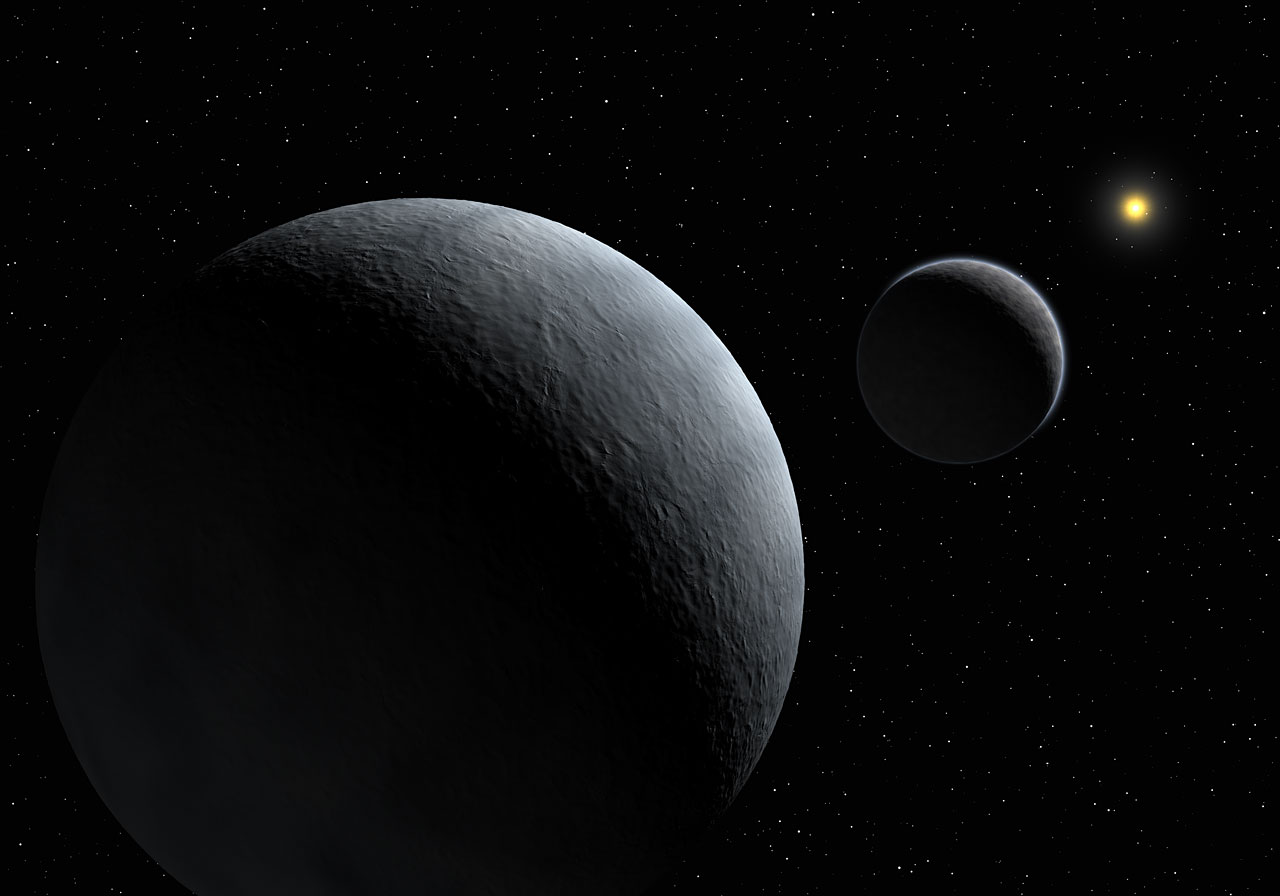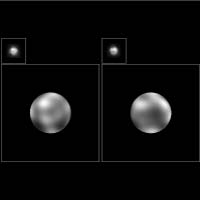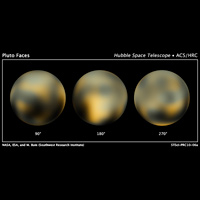
Thirty days from now, on 14 July, a machine fashioned by human hands will speed silently past one of the last great unexplored wildernesses of our Solar System. NASA’s New Horizons spacecraft, launched 9.5 years ago, is close to the culmination of its mission to reveal Pluto—“planet,” “dwarf planet,” “trans-Neptunian object,” or “Kuiper Belt object,” depending upon your preference—and its system of moons, including its binary companion, Charon, as never before. By so doing, New Horizons will bring full-circle our first-time exploration of each of the traditionally accepted nine planets in the Sun’s realm. Although Pluto was formally demoted in 2006 to the status of a dwarf planet, a trans-Neptunian object, and the largest known body in the Kuiper Belt, fierce debate still rages as to whether it ought to be reinstated as a “planet” or retain its somewhat less lofty descriptor. Over the coming days and weeks, AmericaSpace’s New Horizons Tracker and a series of articles by Mike Killian, Leonidas Papadopoulos, and myself will cover the discovery and exploration of Pluto to date, the trials and troubles faced by those who desired to send a spacecraft there, and the unfolding developments as New Horizons seeks to make this unknown world known.
The arrival of the Hubble Space Telescope (HST) in Earth orbit in April 1990 brought about a renaissance in our understanding of the Pluto-Charon system, despite its early technical troubles. In October of that year, just six months after launch, HST’s Faint Object Camera (FOC) successfully imaged the pair for the first time, revealing them to be little more than a fuzzy blob, but subsequent observations provided increasingly exciting views and whetted scientific appetites. More than three years later, in February 1994, following its successful repair the telescope viewed them from a distance of 2.6 billion miles (4.4 billion km) and revealed both as separate, sharp disks. Its data allowed for their respective equatorial diameters to be more carefully refined at 1,440 miles (2,320 km) for Pluto and 790 miles (1,270 km) for Charon, as well as revealing the latter to be somewhat bluer than its host. “A bright highlight on Pluto suggests it has a smooth reflecting surface layer,” it was noted by the Space Telescope Science Institute (STScI). “A detailed analysis of the Hubble image also suggests there is a bright area parallel to the equator on Pluto. This result is consistent with surface brightness models, based on previous ground-based photometric observations.” However, it was stressed that “subsequent HST observations” would be necessary, in order to confirm that the feature was real.
Two years later, in March 1996, further HST data unveiled Pluto as something more than a far-off blob, for the first time. “We’ve been told by STScI that the observations will be scheduled for the weeks of 4 March or 11 March,” explained Dr. Mark Buie of the Lowell Observatory in Flagstaff, Ariz., in a journal entry from January 1996. “During that two-week interval, I’ve calculated when Pluto will show the same side as seen during the other pictures. Those pictures were taken at 115, 112, 203 and 289 degrees East longitude. I’ve chosen longitude 203 as the highest priority because there is an interesting bright spot in the south polar regions and because there are some differences between the visible and ultraviolet images. This longitude shows up three times during the two weeks and have been assigned the highest priorities.” The telescope’s FOC acquired imagery of virtually the entire surface, revealing “a complex object,” with “more large-scale contrast than any planet, except Earth.” Tantalizingly, almost a dozen distinctive albedo features—nicknamed “provinces”—were identified, including a “ragged” northern polar cap, bisected by a dark strip, a bright spot which seemed to rotate with the planet, a cluster of dark objects and a bright linear system of markings. “Hubble has brought Pluto from a fuzzy, distant dot of light to a world which we can begin to map and watch for surface changes,” said Dr. Mark Buie of Lowell Observatory, the very same place from which the frustrating search and eventual discovery of the planet took place.

It was suggested at the time that the sharp albedo variations may have been caused by topographic depressions, including basins and fresh impact craters, as well as possible frosts which migrated across the Plutonian surface with its orbital and seasonal cycles. “Pluto is so far from the Sun that even nitrogen, carbon monoxide and methane gases partially freeze onto its surface during the long period when it is farthest from the Sun,” the STScI explained. Brighter areas were most likely coated with nitrogen ices, but the darker deposits proved more difficult to identify. “They could be exposures of rocky material,” suggested Dale Cruikshank in The New Solar System. “More likely, the Sun’s ultraviolet light has driven reactions within the ice mixture to yield dark, reddish compounds. As in the case of Triton, cosmochemists predict that a host of complex hydrocarbons and nitriles can be created from the known molecules on Pluto’s surface. Polymers of these compounds often have distinctive colors, typically red, orange and black.” Adding their own imprints to the Plutonian mixture were colliding comets in the Solar System’s distant past. Surface temperatures were thought to vary from -235 degrees Celsius (-391 degrees Fahrenheit) to -210 degrees Celsius (-346 degrees Fahrenheit), with the “warmer” regions corresponding approximately to the darker areas.
The images revealed that Pluto was a very individual world and not, as had been supposed, a virtual twin or cousin of Neptune’s large moon, Triton. During a short, warm season during its closest approach to the Sun, many of the frosts on the surface sublimated back to a gaseous state, thickening a tenuous atmosphere of nitrogen, with trace amounts of methane and carbon monoxide, whose existence had been inferred following a stellar occultation and subsequent observation confirmation. Pluto’s atmosphere, like its discovery and that of Charon, came as a surprise. In June 1988, a team of astronomers in the South Pacific observed the planet pass across a 12th-magnitude star, which reappeared gradually, suggesting the presence of gaseous envelope around Pluto. Nitrogen seemed to be the predominant constituent, and it is expected to generate an atmosphere with a surface pressure no greater than 50 microbars.
More recently, in the spring of 2010—by which time New Horizons was already en-route to Pluto—further HST observations with the Advanced Camera for Surveys (ACS) revealed marked changes on the surface over a span of little more than a decade. The images showed “an icy, mottled, dark-molasses-colored world undergoing seasonal surface color and brightness changes,” manifested through a distinct reddening of features and a steady brightening of the northern hemisphere. “These changes are most likely consequences of surface ice melting on the sunlit pole and then refreezing on the other pole, as the dwarf planet heads into the next phase of its 248-year seasonal cycle,” it was explained by the STScI. “Analysis shows the dramatic change in color took place from 2000 to 2002.”

Clearly, Pluto’s eccentric orbit and its Uranus-like axial tilt were responsible for asymmetric seasons, triggering a very rapid transition from spring to summer at its northern pole. Earth-based observations between 1988 and 2002 revealed a doubling in its atmospheric mass, possibly due to warming and the melting of nitrogen ice. “When the Hubble pictures taken in 1994 are compared to those of 2002 and 2003, astronomers see evidence that the northern polar region has gotten brighter, while the southern hemisphere darkened,” the STScI reported in February 2010. “These changes hint at very complex processes affecting the visible surface.”
“A brightening of the north pole is a little odd,” admitted Dr. Mark Buie. “I imagine that a lot of clean surface ice accumulated on the north pole during its winter season. Now it’s coming into view and getting warmed up, I would expect the surface to start out bright and then gradually dim as ice sublimates away and moves to the other pole. But that’s not what is happening and it will be a very important clue to understanding seasons on Pluto and how the surface and its atmosphere interact.”
Those images from HST were significant, for not only did they demonstrate that our understanding of Pluto was as ever-changing as the planet—or “dwarf planet,” or “trans-Neptunian object,”or “Kuiper Belt object”, if you prefer—itself, but they also showed us the limit of our imaging capabilities. With HST, we had reached the peak of our capacity to see Pluto as it really was. It had grown in our imagination, in our consciousness, and in our understanding from a star-like point of light to a real world, with an atmosphere and an attendant companion “moon,” and seasons, but our understanding of how Pluto ticked still remained woefully incomplete. Until May 2015, that is, when New Horizons’ imaging capability exceeded that of HST and a new era began. The coming weeks and months will reveal more about the Plutonian system than we have learned in almost a century of telescopic and space-based observation.
New Horizons’ results will undoubtedly astound and surprise us. They will generate images and critical data, allowing us to peg equatorial diameter and relative distances with accuracy for the first time. They will allow us to map surface features the size of football fields. They will allow us to ascertain colors and textures and craters and canyons and boulders. They will allow us to determine the various chemicals present on Pluto and Charon and—as will be described in next week’s articles—hopefully also in the surfaces of their other moons. And in so doing, they will likely generate many more questions than answers.
This series will continue next weekend, as AmericaSpace explores humanity’s advancing knowledge of Pluto with the discovery of additional moons, beyond Charon, and early frustrated plans for the Pluto Fast Flyby and Pluto Kuiper Express missions.
Want to keep up-to-date with all things space? Be sure to “Like” AmericaSpace on Facebook and follow us on Twitter: @AmericaSpace
Missions » New Horizons »



Excellent article Ben! I don’t think there has been this much excitement in space exploration since the soft landing of the Curiosity MSL. I am eagerly looking forward to the upcoming series of articles by Mike, Leonidas, and yourself. At this history-making time, there are no better researchers and writers to chronicle the event for the ages. What you write now will echo in history, and be read by generations not yet born. Carpe Diem!
Though perhaps not appropriate for this series I personally always enjoy some mention of human travel to these bodies and the speeds necessary to accomplish them within the psychological limits of a spaceship crew. Those limits being longer the larger the spaceship and crew become. Thanks Ben.